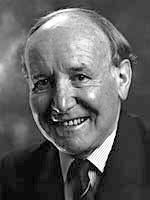Name Ted Ringwood | Role Geophysicist | |
 | ||
Born April 19, 1930Kew, Melbourne, Australia ( 1930-04-19 ) Thesis Studies in geochemistry (1956) Influences Victor Moritz Goldschmidt, Notable awards Died November 12, 1993, Canberra, Australia Books Composition and Petrology of the Earth's Mantle Fields Geochemistry, Petrology, Planetary science | ||
Alfred Edward "Ted" Ringwood FRS (19 April 1930 – 12 November 1993) was an Australian experimental geophysicist and geochemist, and the 1988 recipient of the Wollaston Medal.
Contents
The mineral ringwoodite is named after him.
Early life and study
Ringwood was born in Kew, only child of Alfred Edward Ringwood. He attended Hawthorn West State School where he played cricket and Australian Rules football. In 1943 he was successful in gaining a scholarship to Geelong Grammar School where he boarded. On matriculation, he enrolled in Geology a science degree at the University of Melbourne where he held a Commonwealth Government Scholarship, and was awarded a resident scholarship at Trinity College. He represented the college and the University in football. He obtained First Class Honours degree in Geology and began a MSc degree in field-mapping and petrology of the Devonian Snowy River volcanics of northeastern Victoria, graduating with Honours in 1953. Ringwood then undertook a PhD, beginning an experimental study about the origin of metalliferous ore deposits, but later changed his research topic so as to apply geochemistry to an understanding of the structure of the Earth, in particular the mineralogical constitution of the Earth's mantle.
Germanate and earth's mantle
In the late 1950s and 1960s Ringwood worked on germanates. He discovered that they served as low-pressure analogue to high-pressure silicates. With this insight he was able to predict that the phase changes of the mantle minerals olivine and pyroxene should occur in the Transition Zone. At the Australian National University he began experimental study of silicates at high pressure, and in 1959 demonstrated that the iron end-member of olivine indeed transformed to the denser spinel structure, as did numerous germanate and germanate-silicate solid solutions. In 1966, Ringwood and Alan Major, the technical officer who worked with him from 1964 to 1993, synthesised the spinel form of (Mg,Fe)2SiO4, Also in 1966, the transformation of pure forsterite (Mg2SiO4) to spinel-like phase was achieved.
In 1969 a new mineral was discovered in fragments of the Tenham meteorite which had the same crystal structure as the high pressure spinel polymorph of olivine. This was the first time that Ringwood's predicted polymorph was found in nature. Honouring the importance of Ringwood's work the mineral was named ringwoodite. A team from the University of Alberta have isolated terrestrial ringwoodite in a brown diamond specimen found in Brazil in 2008. Their research suggests the presence of water deep within the Earth's mantle.
Later life
In 1978, his ANU team invented synroc, a possible means of safely storing and disposing of radioactive waste.
Ringwood died of lymphoma on 12 November 1993 at the age of 63.
Honours
Ringwood received numerous honours and awards for his work.
He also received the Werner medal, Arthur Holmes Medal, Harry H. Hess Medal and the J. C. Jaeger Medal.
The European Association of Geochemistry quinquennially awards a Science Innovation Award medal named in his honour for work in petrology and mineral physics.
